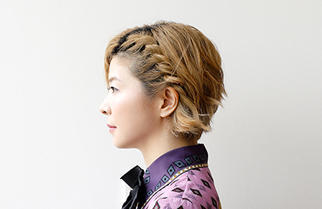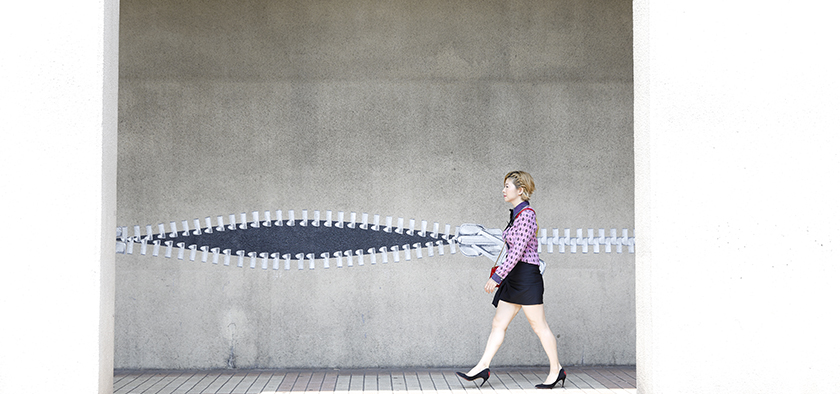
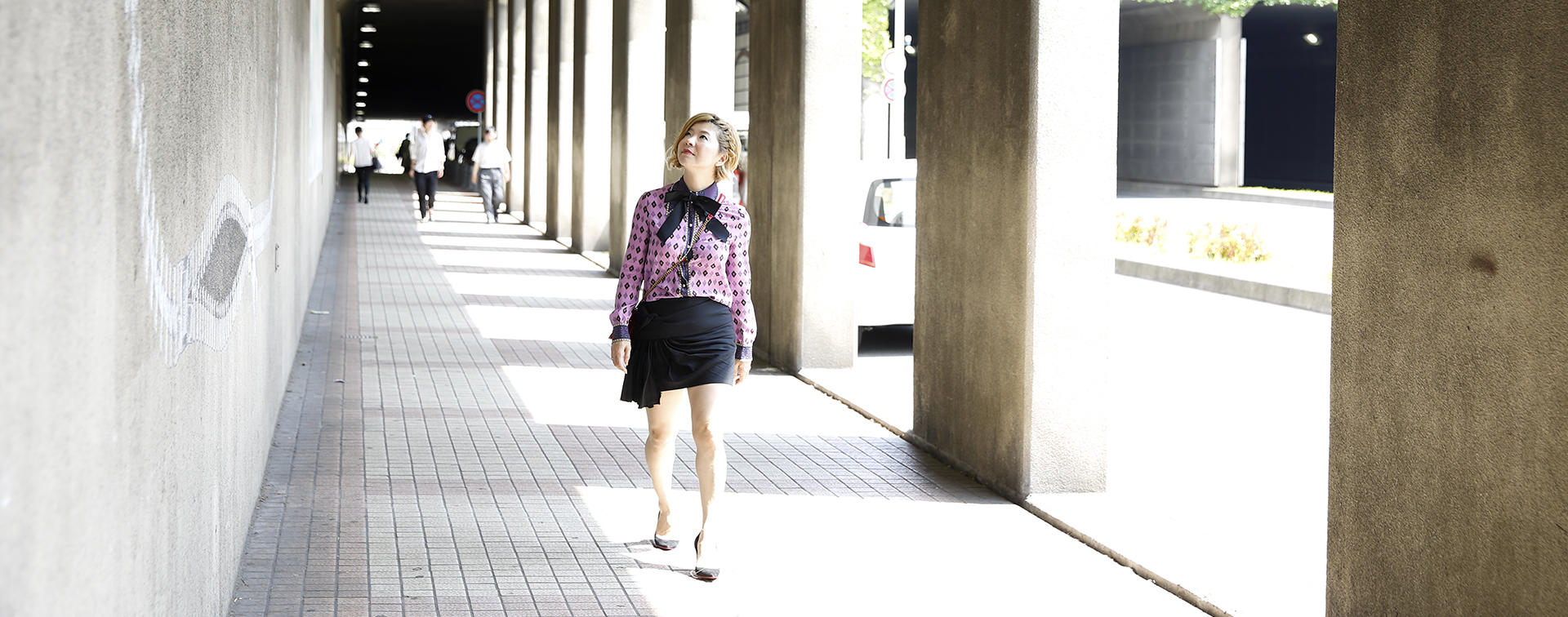
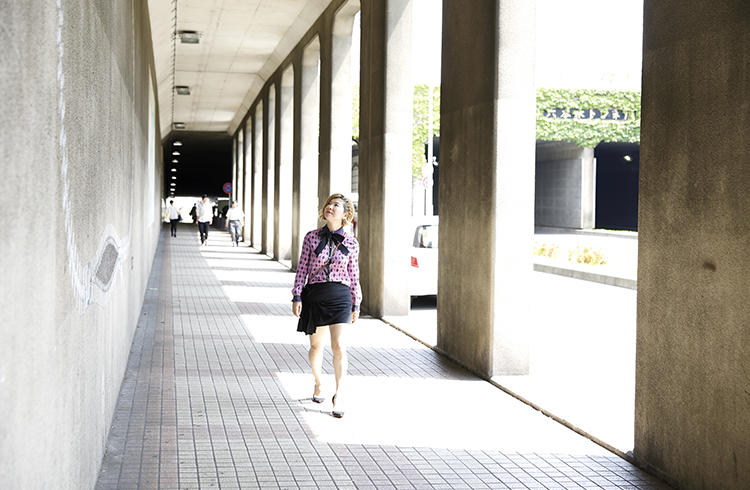
Realizing "Biopresence" by making the most of the interest in Japan
The requirements of a bio art hub
Shiho Fukuhara gained attention in London as a bio artist. While based in Tokyo, she currently travels to cities around the world. Her works blend biotechnology with art and have the effect of shaking our conventional views on life, and raising questions about ethics. Her works include Biopresence where the DNA of a deceased person is preserved in a tree, and Common Flowers / Flower Commons that are genetically-modified blue carnations turned back to white carnations. Fukuhara is an artist in a genre that is likely to grow in the future. We were curious to know about the potential she sees in Roppongi. She gave us interesting views while making comparisons with cities in other countries.
The bio art project which was almost realized in Roppongi
Roppongi is a place I have ties to. My office is now located here, and about two years before Tokyo Midtown was built, I was approached about planting "Biopresence" in the compounds. As I remember it, the concept for the project was "garden" and the area around Midtown Garden was to be the stage. We planned to publicly seek someone who would offer their genes. Under the plan, this person would explain the reason for wanting to preserve his or her genes, and we would make a documentary movie about the growing tree. Preserving human genes in plants had become basically possible. The plan was to choose a tree that would take decades to become big; I remember that we were very excited when talking about how nice it would be if the person's children and grandchildren would visit the tree in later years. But after I candidly pointed out that some people have negative views about the ethical question of genetic modification, it became difficult for the project to go forward...

Biopresence
A project of a "living memorial" where DNA from a deceased person is preserved in the cells of a tree. Shiho Fukuhara and Georg Tremmel (who was Fukuhara's fellow student at the Royal College of Art) jointly showed the work to the public in 2004. Fukuhara conceived the idea for the work after hearing a story about the death of a pet. The project aims to pose fundamental questions about life and death, family, people and society.
Photograph by BCL
When I came back from England and started making artwork in Japan, Roppongi was being transformed into an area of art; the National Art Center, Tokyo had just been built, and many art galleries were relocating here. I lived in Tokyo until I was 18, and there was an image in my mind of Roppongi being a scary place filled with drunken middle-aged men. So when I returned to Japan, it seemed strange to me that Roppongi had become a place for art. Now, of course, it makes sense to me.
Pedestrians in Roppongi are not easily surprised
In May this year, I was invited to participate in the FIS TOKYO (Future Innovators Summit TOKYO) held in Tokyo Midtown. We sat at a table placed in the shopping mall and had a discussion. I think that would normally be considered a peculiar sight, but the people passing by didn't seem to be particularly surprised; they would stop and listen to what we were saying or just look at us from afar as if they were thinking, "Oh, some kind of event is going on." All kinds of events and performances are held in this area, and I thought it was interesting how the passers-by seemed to think anything can happen at any time.
The art galleries in Roppongi are relatively well known overseas, but I think few people abroad regard Roppongi as being an area of art. To spread the view that Roppongi is an area of art, perhaps it would be a good idea to hold Roppongi Art Night for a period of several days instead of just one night. Roppongi Art Night is an event that is very compatible with the lively atmosphere of Roppongi. It's good how people who are not very familiar with art can casually come here on a date and enjoy themselves. It's an event that would be difficult to hold in other parts of Tokyo since it requires a fairly large space. I assume that Roppong Art Night was inspired by La Nuit Blanche in Paris but there is a strong sense of safety in Tokyo with regard to security. The drawback is that the event is so short. This year, I woke up in the middle of the night, intending to go, but I got the date wrong, and the event had already ended the day before. (laughs) There are probably many people like me who have done the same thing. I wish Roppongi Art Night could be held for about three days at least.
There is a similar art event in London, and all the art galleries gathered in one area are open at the same time as the event. Visitors have the opportunity to drop in the various art galleries, and the art galleries are able to have easy publicity. Alcohol is often served at the opening of the event, so there are people who come for the drinks; other people, expecting to meet their friends, bring their own drinks and have fun in the streets. It's a win-win situation that works efficiently. I wish the same kind of thing can happen in Roppongi where there are many art galleries.
Bio artists around the world should come to Japan
Bio art has a short story in Japan, and it is not widely recognized yet. So there is the possibility of all kinds of bio artists and works appearing in the future. In Europe and America, the definition of bio art is fairly fixed, but in Japan, its definition is still loose. Before, I used to have a narrow way of thinking and I thought that works based on movies and photographs could not be called bio art; I believed that biological phenomena should be used as materials and methods for making bio art. That raised the hurdle, but I thought this hurdle was important for all kinds of creativity, and I didn't like works that just told a story. Recently however, I've come to think that accepting those kinds of works is in line with the Japanese spirit, and that it contributes towards diversity and tolerance in Japan. So I am no longer particular about what should be defined as bio art.
A recent trend I find interesting is the connection that biotechnology has with economic activity. Advances in biotechnology are now faster than advances in Internet and computers, and investors are apparently sensing a lot of potential in biotechnology. Looking at the media and other factors, I feel that trends in biotechnology last longer in Japan than in other countries. Taking that into account, I think bio artists around the world should come to Japan. We ourselves are doing activities to invite people. The encouraging thing is that there are few regulations in Japan at the moment. There are some genetic modification experiments which would be difficult to conduct in Europe and America, but which can currently be conducted in Japan. We should definitely make the most of an environment that is permissive to bio artists.

The rules in Japan are not as rigid as they seem
When you walk up Dogenzaka in Shibuya, you find FabCafe at the top of the slope; on the second floor of this establishment is a co-working place called MTRL TOKYO that can be rented by creators on a daily or monthly basis. At the back of this space is a storage-room like room; we made a wet lab called BioClub there where bio artists can make things. Well, I was simply the person who proposed making it and didn't do much else. (laughs) We have a proper license, so we can do genetic modification experiments and we are also holding talk events and workshops. Things have finally got underway recently: we have invited artists from Europe through funding, and we have started collaboration projects with Asian artists.
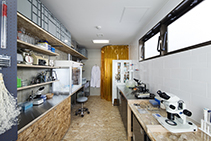
BioClub
A laboratory and meeting place for people interested in science which was founded by Fukuhara and others as an alternative space to a university or company laboratory. People gather to discuss all kinds of themes in biotechnology. A meeting is held every Tuesday which is open to everyone and which first-timers can observe.
People tend to think that Japan has many restrictive rules, but I think some of the rules can be broken. One manifestation of this is that there are so many exceptions to the rule; this means individuals are allowed to take action based on their own perceptions of what is permissible. I find that interesting. In America for examples, rules are absolute, and there is no room for negotiation. In France, there are few rules, but the rules are very rigidly implemented. It's as if they don't care in the least if the rules make you cry or whatever. (laughs) Both America and France are countries which have historically seen an influx of foreigners, so they probably needed to have strict rules to protect their culture.
Bio art and the Japanese belief in reincarnation
People's response to bio art differs according to each country. In England for example, Biopresence is treated almost like a taboo. The media might report it, but 90% of the reporting is likely to be criticism. I've received angry letters and there was a time when a person came to an exhibition yelling "Where is Shiho Fukuhara?" I remember being scared. (laughs) In France, there were enthusiastic discussions about whether such works constitute art. Meanwhile in Japan, people don't talk about ethics or art; surprisingly, many people seem to accept the works with an attitude of "It's an interesting idea." I think the Japanese are very curious about interesting things, and their curiosity for the unknown is stronger than their fear of it.

Biopresence 2055
The "Biopresence" installation released by Shiho Fukuhara and Georg Tremmel. It was exhibited in Japan in 2005 at the "Open Nature" exhibition at NTT Intercommunication Center (ICC).
Photograph by Keizo Kioku
We once exhibited a work called Biopresence 2005 for a year at the Science Museum in London, and after that, we exhibited it for three months at ICC in Tokyo. The response to the work was remarkably different. In England, the response was mainly an angry one, with people making comments like, "I don't understand the meaning of making such a work", and "This is blasphemy against God." In Japan, people were making all kinds of remarks, such as "It looks like a Godzilla cell", "Can I go in there with my family?" or "I would like to become a Somei Yoshino cherry tree." The concept of preserving human genes in a tree probably doesn't seem that unnatural to the Japanese because of the ingrained sense that God is in all of life, and because of our belief in incarnation. The response was so innocent that I felt weakened with surprise. (laughs)

ICC
NTT Intercommunication Center (ICC) is a cultural facility which opened in April 1997 at Tokyo Opera City Tower in Nishi Shinjuku. It exhibits media art and artworks that use the latest technology. Workshops, performances, gallery tours and children's programs are held.
Photography courtesy of NTT Intercommunication Center (ICC)
The lack of precedent makes people in Japan wary
When you explain that something is a work of art, you can get away with so many things, and that is precisely why art is treated as something that doesn't belong to everyday life - something that is unreal. I have a strong desire to change that way of thinking. I believe that art should be set free from the white cubes of art galleries and be blended into the streets. That desire is behind my choice to use trees as materials. We set up the company Biopresence in London with funding from the government; I wanted people to see that artworks are things that are close to our everyday lives. I thought it was an opportunity for people to seriously think about art. The most frightening thing for me as a creator is when there is no response to what I have made. A negative response would be better than no response at all because there's significance in thinking about the reason for feeling discomfort or aversion. When we go about our everyday lives, we don't have many opportunities to become excited or to ponder about small puzzling matters. Art helps to evoke those emotions. I think it's like sports.
Biopresence has not yet been realized, but there are studies that due to the advance in technology, the budget would be about a hundredth of the sum that was estimated to be necessary when we initially released the work. A big factor for this is that we can now do the work ourselves instead of asking scientists to do the work for us. It's easy to give up when faced with obstacles, but there is the possibility that many other methods can be taken to reach your goal. You might not be able to break down one wall, but if you doggedly keep planting seeds in all kinds of places, things might go well a decade later. If you keep going forward with the unwavering determination to make something a reality, I believe a time will come when all the efforts you have made - all the seeds you have sown - will take you to your goal.
Of course, our project might be realized in Japan, but the Japanese are so wary of things that are without precedent. In contrast, people in Europe and America fearlessly go ahead because they know that something without precedent means that rules have not been made yet. Their approach is to nonchalantly do it, and accept the scolding that might come later. In Japan, people think too much about the scolding they might get; it seems to me that a lot of projects are suddenly turned down because of that. Not going forward with a project means that nothing is happening, and in the long term, it is tantamount to a big failure. This way of thinking is probably taken with everyday matters too, and not only with big projects.
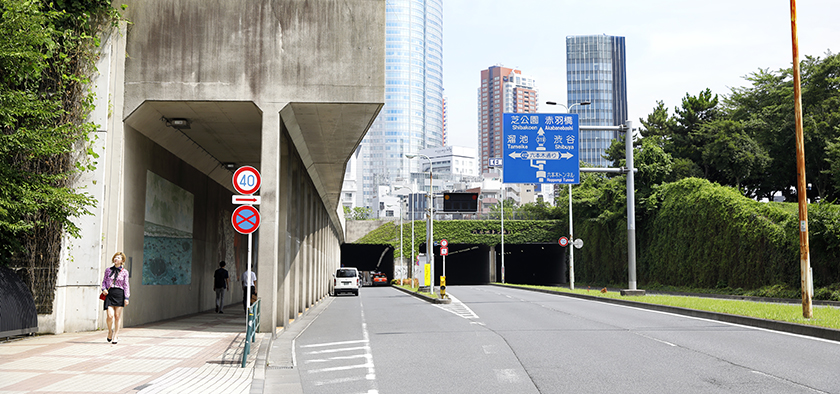
Enjoying the huge art installations in the streets
In Roppongi, there are big art installations in the streets here and there. At the airport in the Netherlands, you often see such installations which are called "airport art." There is something humorous about a big work of art that you suddenly encounter; when you search for the name of the artist, it's not often clear. These art installations are mysterious in many ways. In Japan though, many such works are surrounded by fences so that people can't come near them, presumably for safety reasons such as preventing injuries. But I think people should be responsible for their own actions. You might touch a big art installation in the summer and it might be burning hot, but by that very action, you would be making a scientific discovery.
In Gifu, there is a theme park called "Yorotenmei hantenchi." People enjoy the artworks by not only looking at them, but also touching and climbing them, so there's always the possibility of getting injured. The visitors know the risks but take their own responsibility and enjoy themselves. When children play in the park, they experience things that might be dangerous, and they learn a lot of things along the way. Children who grow up in an environment that is overly clean and safe will not have immunity, and will probably suffer big injuries when they are adults, don't you think?

Yorotenmei hantenchi(House of Critical Resemblance)
A theme park in Gifu Prefecture's Yoro Koen. Created by artist Shusaku Arakawa and his partner, the poet Madeline Gins, the facility is a work of art that can be explored physically. It consists of a main pavilion called the Site of Reversible Destiny and a bowl-like basin called Elliptical Field. Visitors can enjoy art in an athletic way by moving through the undulating terrain.
Combating pollen allergy by increasing parks in towns
When you look at towns though the perspective of bio art, you will find that there are quite a lot of projects that involve cities and biotechnology. For instance, I once worked on a project to keep bees on the roof of a building in Nagatacho. Bees spread out in quite a wide area, so we were able to do things like collecting bacteria from the pollen on bees and making bacteria maps of the streets. At Bio Club, there have been people who collected bacteria from all kinds of places to make bacteria maps.
There are many materials for bio art in the city, but I think Tokyo should have more trees. Compared to the world's cities, the number of parks in Tokyo is extremely few. When one wants to look at the sky, the quickest way is often to go to the top of a building. Midtown Garden is a precious place because while it is surrounded by buildings, there is an interrupted view of the sky. Looking intensely at art can be tiring, so I feel grateful for an oasis-like area like Midtown Garden.
Pollen allergy is the result of too many trees of the same kind being planted. The problem of pollen allergy will not be fundamentally solved by reducing the number of trees or trying not to go anywhere near trees. A different way of thinking should be adopted; steps should be taken such as planting trees of more diversity. Since pollen is not absorbed in asphalt, we should also increase areas that have soil instead of asphalt. We should also have more parks. We need to take action now otherwise a 100 or 200 years from now, people might be not be able to go near trees and it would be too late then. The eco system is also an important aspect of town development, and I hope that proper ecological designs will be put in place.
Editor's thoughts
Fukuhara-san told us that she has recently been going back and forth between Paris and Tokyo. We are glad that she took time out from her busy schedule to give us an interview. Fukuhara-san's artworks give us an opportunity to think about life. She said her artworks are always born from simple questions that come to her. "Under pressure, the ideas would not come to me," Fukuhara-san said, adding, "The important thing is not to give up during the long process of transforming the idea into art." While she talked in a matter-of-fact manner, I sensed that Fukuhara-san is a possessor of a very strong will. (text ikuko hyodo)




